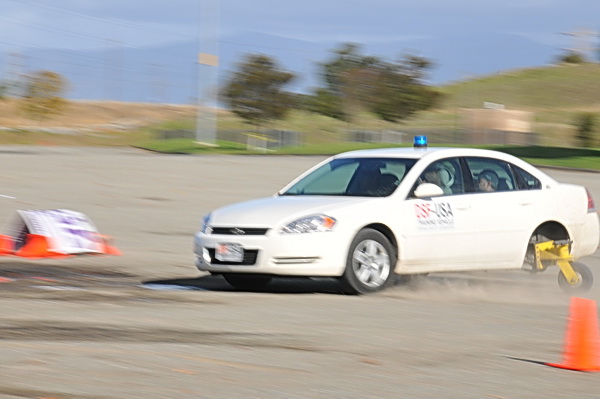
Third lesson: How to handle a decreasing-radius turn. You know the one… where you head into the corner happily, only to find out that the corner is getting tighter and tighter and tighter and the next thing you think, “Oh &^@%!”. Yup. You just met the decreasing-radius turn. This was setup as a series of cones rounding a normal corner and then there was a gap in the cones that you needed to get the car through. Hence: your decreasing radius corner. If you were conservative and took it slowly, you had to speed up the next time! After making the corner, we were asked to come to a stop. Much, much easier at slower speeds. And much less dust was flying at those lower speeds too. Of course, taking it at speed was an excellent lesson, which some of us embraced more fully than others!
Fourth lesson: How to drive in a continuous circle (a.k.a. skid pad test). Seems easy enough. You just keep driving in a circle. But with the Skid Monster, you’d be turning to the right continuously, while the rear end of the car was spinning around and following the direction the front end was taking. It felt as though we weren’t driving, but actually continuously spinning! I felt like James Bond on an oil slick and was doing really great, till Jeff “pulled the lever”. The one that sent us into an unrecoverable spin and no amount of counter steering saved me that time. I countered by turning the wheel “hard over” to the left, and then there was nothing else I could do. We spun out and the car stopped. I’m pleased that I was not one of the two students who actually killed the engine when we spun out (I’m still not quite sure how that happened in an automatic, but I know that mad skilz were involved).

Fifth lesson: How to avoid an obstacle in the road. You know the scene. You’re driving down the highway, having a grand old time, and the next thing you know, the truck in front of you drops a refrigerator in your path! Or a mattress (don’t laugh, I’ve seen someone high-centered on a mattress before), or a lawn-mower, or a car just fell off the tow-truck (hey, anything can and does happen out there). Regardless of the obstacle, how you react to that obstacle is key. It’s also about knowing your surroundings. Can you switch lanes, or are you completely boxed in? If you can move safely around it, what do you do? In our case, we’d be driving straight toward the object gaining speed. Jeff would call out, “Turn left!” or “Turn right!” and we had to turn the wheel in that direction, then as the car started to skid, counter steer the other direction (but not too far) to bring it back around, then stop. It was my favorite lesson of all of them! The last time I did it, I just knew I was going to be thrown a monkey wrench. He’s telling me, “Go faster. Faster. Faster!” and the car was all over the place. I’m heading toward the obstacle and the car is fishtailing left, then right, then left, and the back end is heading right, the front is heading left and I thought, “I bet you he says, “go right”, which of course, he did. ACCCKKKKK!!! I turned right and the car came around, but then I had to hurry up and counter back to the left, then adjust a bit right and then hit the brakes! I cannot believe I didn’t hit the obstacle. Mary-Ellen tagged the cones on that drill a few times and it sounded like she ran over a person. We were all giggling about “you ran over the baby!”. One of the other students actually took out the entire obstacle (a plastic sign), which Sia had to go put back into place!
Other important safety items:
- Hand-placement on the steering wheel. You always want both hands on the wheel and the ideal positions are 9 and 3 o’clock, or 8 and 4 o’clock. Any higher and your hands can get in the way of an airbag deployment!
- Keeping your eyes up and on your target area. Don’t look down. Don’t look at where you don’t want to go (and don’t look at your cell phone!). Always keep your eyes up, look where you WANT to go and the car will follow.
- Windows rolled up. They are strong and meant to resist breaking, but… having the window partially down in a side-impact collision can really cause you serious harm. It can inadvertently send your head into the window edge, turning the window into a guillotine. I know this made me seriously re-think cracking the windows for air!
- Keep the car in balance by starting and stopping smoothly. Any time you rapidly accelerate or brake, the pitch forces are thrown out of balance and it results in less control of your car.
Conclusion: Even though I haven’t driven in compact snow and ice for a few years, this class, the car, and the road surface was a perfect simulation of those exact type of driving conditions. Jeff was also really good about pointing out what we did right, as well as what we did wrong. As I noted previously, I think we all agreed that we learned a lot more in a group setting, than if had been one-on-one. Everyone learns the most from making mistakes, and some were definitely made. But all of us learned from it, and I know Mary-Ellen and I walked away happy, having had a positive experience with this class. I’d highly recommend it for anyone wanting to learn how to be a better, safer driver.

###
About DSF:
Driving Safety Foundation, or DSF, in association with the National Institute of Driving Behavior, provides the core knowledge necessary for both novice and experienced drivers to gain complete control on the road. Education is an essential component in the quest to reduce crashes, injuries and fatalities.
DSF is recognized across the state of California by high schools and driving schools as the provider of NIDB College curriculum and technology in educating drivers of all ages, with specific emphasis on teenage and novice drivers. We stand to provide life-long learning and habit development for driving risk prevention. We strive to help our students acquire preventative behavior habits that aid in minimizing, avoiding, and completely eliminating undue risk. We partner with highly esteemed driving schools around the state to bring to you the country’s #1 driving technology and curriculum.



Pingback: Locksmith Denver
Safety Driving Foundation is a good one. Thanks for sharing the information with us and would like to hear more from you.
Pingback: Table of Contents – Expert Reviews - suzuki 125
I can see that you put a lot of hard work on your blog, I’m sure I’d visit here more often.Great job, keep posting interesting articles here. All The Best
Safety Driving Foundation is an Great idea to come out. Thanks for sharing the information
Hi,
Really DSF is very useful class for safety Driving. Learners driving permits are also often referred to as provisional licenses. These licenses allow young drivers on the roads but only under certain provisions.
Thanks
Sofia.
Thank you all for coming out, and we really appreciate the article!
-Sia Bani
Well first off, thanks Derek for coming out and taking the course. I’m happy you all had a good time and actually learned something.
Poor Max, he was so ill. I think next time I’ll hookup my G-Tech Pro in the back seat and record the g forces . . . ; )
Thanks for the write up Holly. I’m very glad you walked away with so much more new-found knowledge. Glad you enjoyed the course, hopefully you’re ready to tackle this coming ski season now!